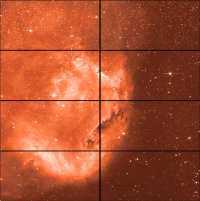The Galactic Bulge Survey
This page provides details of a large research project that we are
undertaking. The main idea is to image an area of 6x1 degrees centered on the
Galactic Center at |b|=1.5 degrees: the Galactic Bulge Survey. These regions
have been selected because of their lower extinction and crowding in the optical
and near-infrared than in the Galactic Center area, while still having a high
density of X-ray sources. We have detected a plethora of faint X-ray sources
that will constrain binary evolution models by way of a number count and by
identifying predicted X-ray binary types that so far have eluded identification.
We expect to find (quiescent) eclipsing neutron star and black hole LMXBs. These
are important for neutron star and black hole mass measurements.
Many high-energy phenomena
are driven by accretion onto compact objects. The close binaries responsible
for these sources went through one or two phases of common-envelope evolution.
This includes white dwarf binaries such as CVs and AM CVns, and the various
families of X-ray binaries. Also the rates of Type Ia SNe from different
mechanisms and the rates of production of Gravitational wave radiation sources
are strongly dependent on how common envelope evolution works. However, that
phase is not yet understood (i.e. Ivanova et al. 2012). Compact binaries have
much lower orbital energy and angular momentum than the progenitor binary that
contained giants (Paczynski, 1976). The binary semi-major axis is thought to
shrink mainly during a phase of unstable mass transfer and ejection, the
spiral-in. If the outcome of this process is derived by assuming that the
change in orbital energy is enough to eject the giant's mantle, the predicted
properties do not match the observations of double white dwarf binaries. These
properties can be matched with the assumption that the giant's mantle is
ejected, carrying the specific orbital angular momentum (Nelemans et
al. 2000), but this begs the question how the required energy is provided. It
is clear that a more complete theoretical description is required that takes
into account both energy and angular momentum.
\indent To make progress on this issue we envisage a two-pronged
approach by detailed studies of individual systems on one hand, and
of the population on the other hand. Any viable evolutionary scheme
must be able to reproduce the specific properties (such as component
masses, orbital period, age, system velocity) of each observed
individual system. Any viable evolution scheme must also reproduce
the distributions of and correlations between these properties in
the population of X-ray binaries. Observationally this implies the
production of large homogeneous samples of X-ray binaries, and the
detailed follow-up of a number of individual systems (i.e. Ratti,
Jonker et al. 2012). In table 2 of Jonker et al. (2011) we provide
the number of sources that we expect to discover in the full GBS
area. We will compare our identifications with the predicted
numbers of binaries in each category and that way place strong
constraints on the common-envelope phase in binary evolution.
For dynamical mass measurements in LMXBs one needs to measure
three parameters: the radial velocity amplitude of the companion star
(K), the ratio between the mass of the companion star and the neutron star or
black hole (q) and the inclination. A measurement of the rotational
broadening of the stellar absorption lines (v sin i) combined with
K gives this determination of q. The system inclination can be
determined through modelling of the multi-colour optical lightcurves
or, in systems with favorable viewing angles the X-ray eclipse
duration can be used to accurately determine the inclination (Horne
1985). Since the inclination is constrained by the geometry, mass
measurements in eclipsing systems are independent of the modelling
that lies behind inclinations derived from ellipsoidal
variations. Furthermore, the compact object mass is much more weakly
sensitive to inclination when the inclination is high - one does not
need to know the inclination very precisely to still have a small uncertainty in
the mass measurement. Therefore, quiescent eclipsing systems are *prime*
targets for mass measurements. Such mass measurements provide
constraints on the neutron star equation of state (EoS). Constraining the neutron star EoS
remains one of the final goals for neutron star studies.
Note that with the GBS we are discovering the first-ever low-mass
X-ray binaries selected in X-rays while in quiescence. These systems
have not recently gone through an outburst cycle! Hence, we will be
able to investigate if there are selection effects in, for instance, neutron star
or black hole mass between systems that went through a recent outburst cycle
or not. One can envisage models where high mass-ratio systems have
outbursts more frequently (tidal effects are stronger in high
mass-ratio systems). This would imply that the currently known black hole
sample favors high mass-ratio systems hence relatively high mass black hole
systems. This could potentially explain the apparent lack of low-mass
(3-5 Msun) black holes found (Remillard & McClintock 2006) which is
important input for supernova models (but see Kriedberg et
al. 2012 for an alternative explaination for the lack of low-mass black holes).
Eclipsing black hole LMXB systems should exist, but have not yet been found
although black hole sources showing dips are known (e.g. Corral-Santana et
al. 2013). It has been proposed that they are too weak to be detected
by current X-ray all sky monitors because they are obscured behind the
accretion disc rim (Narayan & McClintock 2005). If so, they should
turn up in our GBS. The number of eclipsing sources depends on the
distribution of the mass ratio between the accretor and the donor star
(see e.g. Horne 1985). For mass ratios q~0.3 approximately
20-25 per cent of the 120 new quiescent LMXBs we expect to discover
should be eclipsing of which several should be black holes.
|

